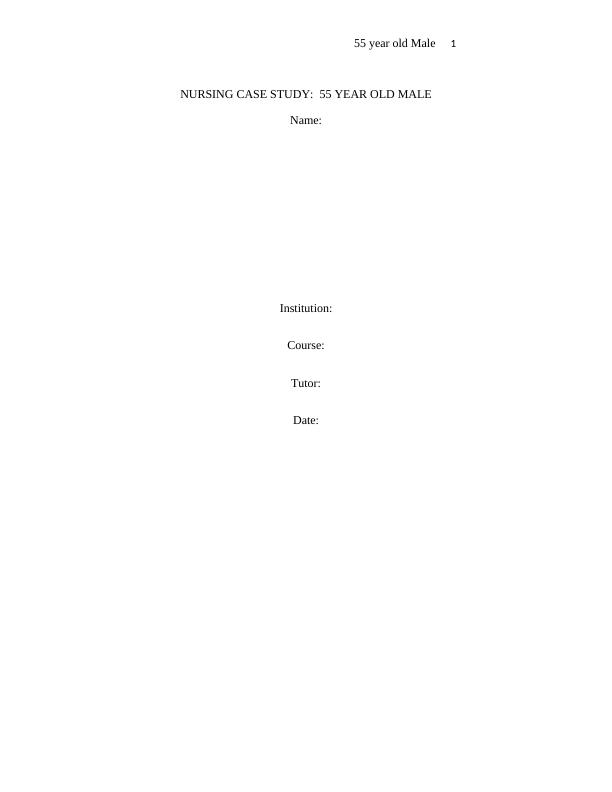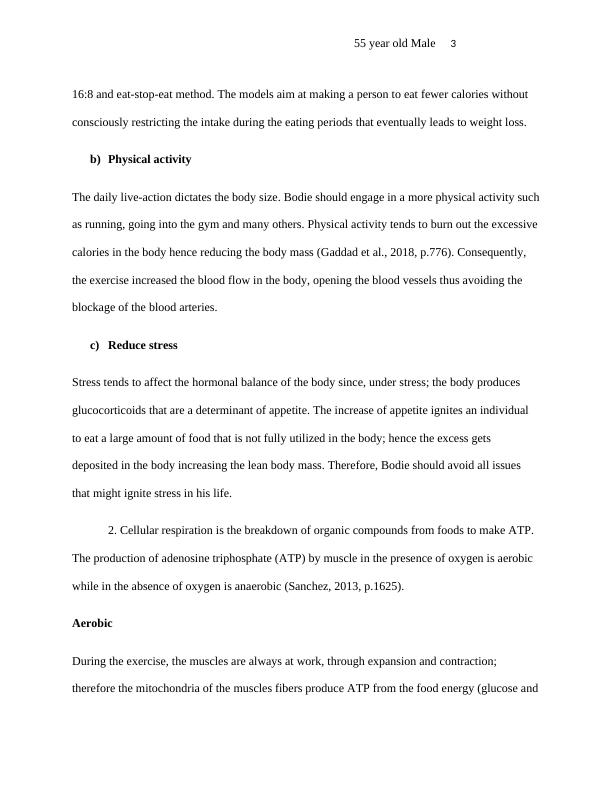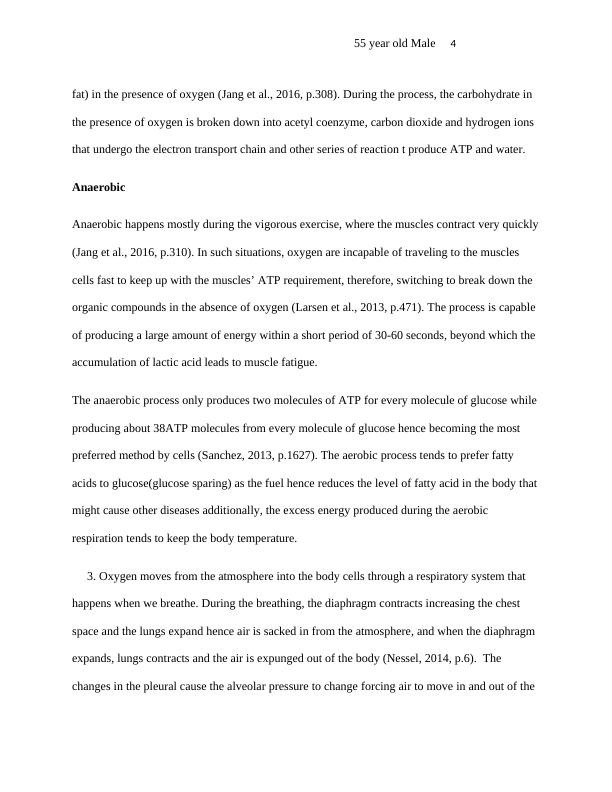Nursing Case Study: 55 Year Old Male
Added on 2023-06-05
13 Pages3648 Words177 Views
55 year old Male 1
NURSING CASE STUDY: 55 YEAR OLD MALE
Name:
Institution:
Course:
Tutor:
Date:
NURSING CASE STUDY: 55 YEAR OLD MALE
Name:
Institution:
Course:
Tutor:
Date:

55 year old Male 2
This a nursing case studies on a 55 year old male, with a height of 185 cm, weight of 95 kg
and waist circumference of 100 cm.
1. The body size interpretation depends on two major factors: weight and height. The
standard metric used to interpret the body size is the BMI that recommends 18.5 to 25 for both
male and females and higher than that increase the probability of health problems such as obesity
and heart attack (Lin 2018, p.2). Using the BMI calculator of height against weight, Bodie BMI
is 27.8, which is above the recommended. This is proves that Bodie is overweight and needs to
reduce the pressure to avoid cardiovascular diseases such as heart attack through the following
recommendations:
a) Eat wisely
Food provides both the energy and the production of the lean mass in the body. Most of the
meals are rich in calories, especially fatty and sugary foods. The body tends to use a specific
amount of food, and the excess is deposited in the body in the form of fats, that increase the body
size. Therefore, Bodie should check on the types of the foods consumed by avoiding food such
as whole grains, nuts, and red meats among many others and increase the consumption of fibers
and water (Young et al., 2018, p.6). Bodie should also reduce the portion of food consumed to
reduce the deposition of excessive fat in the body. The eating speed should also be reduced to
allow the body to detect when it is full: through this Bodie will avoid taking excess food.
Additionally fasting intermittently helps also in reducing the body weight. Fasting intermittently
refers to an eating pattern those cycles between periods of fasting and eating such as 5:2 diet,
This a nursing case studies on a 55 year old male, with a height of 185 cm, weight of 95 kg
and waist circumference of 100 cm.
1. The body size interpretation depends on two major factors: weight and height. The
standard metric used to interpret the body size is the BMI that recommends 18.5 to 25 for both
male and females and higher than that increase the probability of health problems such as obesity
and heart attack (Lin 2018, p.2). Using the BMI calculator of height against weight, Bodie BMI
is 27.8, which is above the recommended. This is proves that Bodie is overweight and needs to
reduce the pressure to avoid cardiovascular diseases such as heart attack through the following
recommendations:
a) Eat wisely
Food provides both the energy and the production of the lean mass in the body. Most of the
meals are rich in calories, especially fatty and sugary foods. The body tends to use a specific
amount of food, and the excess is deposited in the body in the form of fats, that increase the body
size. Therefore, Bodie should check on the types of the foods consumed by avoiding food such
as whole grains, nuts, and red meats among many others and increase the consumption of fibers
and water (Young et al., 2018, p.6). Bodie should also reduce the portion of food consumed to
reduce the deposition of excessive fat in the body. The eating speed should also be reduced to
allow the body to detect when it is full: through this Bodie will avoid taking excess food.
Additionally fasting intermittently helps also in reducing the body weight. Fasting intermittently
refers to an eating pattern those cycles between periods of fasting and eating such as 5:2 diet,

55 year old Male 3
16:8 and eat-stop-eat method. The models aim at making a person to eat fewer calories without
consciously restricting the intake during the eating periods that eventually leads to weight loss.
b) Physical activity
The daily live-action dictates the body size. Bodie should engage in a more physical activity such
as running, going into the gym and many others. Physical activity tends to burn out the excessive
calories in the body hence reducing the body mass (Gaddad et al., 2018, p.776). Consequently,
the exercise increased the blood flow in the body, opening the blood vessels thus avoiding the
blockage of the blood arteries.
c) Reduce stress
Stress tends to affect the hormonal balance of the body since, under stress; the body produces
glucocorticoids that are a determinant of appetite. The increase of appetite ignites an individual
to eat a large amount of food that is not fully utilized in the body; hence the excess gets
deposited in the body increasing the lean body mass. Therefore, Bodie should avoid all issues
that might ignite stress in his life.
2. Cellular respiration is the breakdown of organic compounds from foods to make ATP.
The production of adenosine triphosphate (ATP) by muscle in the presence of oxygen is aerobic
while in the absence of oxygen is anaerobic (Sanchez, 2013, p.1625).
Aerobic
During the exercise, the muscles are always at work, through expansion and contraction;
therefore the mitochondria of the muscles fibers produce ATP from the food energy (glucose and
16:8 and eat-stop-eat method. The models aim at making a person to eat fewer calories without
consciously restricting the intake during the eating periods that eventually leads to weight loss.
b) Physical activity
The daily live-action dictates the body size. Bodie should engage in a more physical activity such
as running, going into the gym and many others. Physical activity tends to burn out the excessive
calories in the body hence reducing the body mass (Gaddad et al., 2018, p.776). Consequently,
the exercise increased the blood flow in the body, opening the blood vessels thus avoiding the
blockage of the blood arteries.
c) Reduce stress
Stress tends to affect the hormonal balance of the body since, under stress; the body produces
glucocorticoids that are a determinant of appetite. The increase of appetite ignites an individual
to eat a large amount of food that is not fully utilized in the body; hence the excess gets
deposited in the body increasing the lean body mass. Therefore, Bodie should avoid all issues
that might ignite stress in his life.
2. Cellular respiration is the breakdown of organic compounds from foods to make ATP.
The production of adenosine triphosphate (ATP) by muscle in the presence of oxygen is aerobic
while in the absence of oxygen is anaerobic (Sanchez, 2013, p.1625).
Aerobic
During the exercise, the muscles are always at work, through expansion and contraction;
therefore the mitochondria of the muscles fibers produce ATP from the food energy (glucose and

55 year old Male 4
fat) in the presence of oxygen (Jang et al., 2016, p.308). During the process, the carbohydrate in
the presence of oxygen is broken down into acetyl coenzyme, carbon dioxide and hydrogen ions
that undergo the electron transport chain and other series of reaction t produce ATP and water.
Anaerobic
Anaerobic happens mostly during the vigorous exercise, where the muscles contract very quickly
(Jang et al., 2016, p.310). In such situations, oxygen are incapable of traveling to the muscles
cells fast to keep up with the muscles’ ATP requirement, therefore, switching to break down the
organic compounds in the absence of oxygen (Larsen et al., 2013, p.471). The process is capable
of producing a large amount of energy within a short period of 30-60 seconds, beyond which the
accumulation of lactic acid leads to muscle fatigue.
The anaerobic process only produces two molecules of ATP for every molecule of glucose while
producing about 38ATP molecules from every molecule of glucose hence becoming the most
preferred method by cells (Sanchez, 2013, p.1627). The aerobic process tends to prefer fatty
acids to glucose(glucose sparing) as the fuel hence reduces the level of fatty acid in the body that
might cause other diseases additionally, the excess energy produced during the aerobic
respiration tends to keep the body temperature.
3. Oxygen moves from the atmosphere into the body cells through a respiratory system that
happens when we breathe. During the breathing, the diaphragm contracts increasing the chest
space and the lungs expand hence air is sacked in from the atmosphere, and when the diaphragm
expands, lungs contracts and the air is expunged out of the body (Nessel, 2014, p.6). The
changes in the pleural cause the alveolar pressure to change forcing air to move in and out of the
fat) in the presence of oxygen (Jang et al., 2016, p.308). During the process, the carbohydrate in
the presence of oxygen is broken down into acetyl coenzyme, carbon dioxide and hydrogen ions
that undergo the electron transport chain and other series of reaction t produce ATP and water.
Anaerobic
Anaerobic happens mostly during the vigorous exercise, where the muscles contract very quickly
(Jang et al., 2016, p.310). In such situations, oxygen are incapable of traveling to the muscles
cells fast to keep up with the muscles’ ATP requirement, therefore, switching to break down the
organic compounds in the absence of oxygen (Larsen et al., 2013, p.471). The process is capable
of producing a large amount of energy within a short period of 30-60 seconds, beyond which the
accumulation of lactic acid leads to muscle fatigue.
The anaerobic process only produces two molecules of ATP for every molecule of glucose while
producing about 38ATP molecules from every molecule of glucose hence becoming the most
preferred method by cells (Sanchez, 2013, p.1627). The aerobic process tends to prefer fatty
acids to glucose(glucose sparing) as the fuel hence reduces the level of fatty acid in the body that
might cause other diseases additionally, the excess energy produced during the aerobic
respiration tends to keep the body temperature.
3. Oxygen moves from the atmosphere into the body cells through a respiratory system that
happens when we breathe. During the breathing, the diaphragm contracts increasing the chest
space and the lungs expand hence air is sacked in from the atmosphere, and when the diaphragm
expands, lungs contracts and the air is expunged out of the body (Nessel, 2014, p.6). The
changes in the pleural cause the alveolar pressure to change forcing air to move in and out of the

End of preview
Want to access all the pages? Upload your documents or become a member.
Related Documents
Comparison of Male Adult BMI in Australia: Sample vs Population Mean Differencelg...
|10
|2738
|59
Case Study on BMI and Coronary Artery Diseaselg...
|4
|792
|113
Weight Management Case Study 2022lg...
|11
|3436
|21
Literature Review on Obesity: Causes, Symptoms, Related Diseases, and Interventionslg...
|7
|1448
|96
Anatomy and Physiology Study Material with Solved Assignments and Essayslg...
|10
|3823
|352
Functioning of Body Systemslg...
|9
|3225
|435
